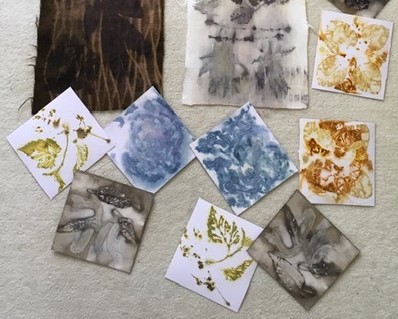Learning Curves – Part 2
Following on from my recent post….
The workshop with Clare was very different, in that it was nuno felting and very small. It was quite a surprise to a few of us (with felting experience) that she only uses one ‘thin’ layer of merino wool, to which she then adds various fine open weave strips of fabric. She creates small (often randomly shaped) pieces approx 15 x 10cm (6 x 4ins) which she carries everywhere in her bag to embroider on during any spare moment, hence ‘Travel cloth’. Once stitched Clare then stitches the pieces together to make a bigger cloth.
-

Clare’s work -

With the previous workshop result still frustrating me I established, before the due date, what our goal would be and decided to create a monochrome scheme (obvious here that I was now avoiding colour!) and set to rummaging in my monochrome stash.
We were given a list of materials etc to bring which included white merino wool and fine fabrics. As I have a very ‘what if’ enquiring mind (I’m a great fan of Zed’s experiments) I took along self carded shetland wool (of which I have a large amount) and a variety of thick, thin, and textured fabrics….my thinking….this would be the ideal opportunity to experiment.
Just a few of the fabrics I used. Left photo – top left was a skirt, top right was a jacket, the bottom 3 fabrics were blouses. All from car boots, washed then cut up and stored. The grey fabric centre bottom (on top of the cream) is vilene I stripped from the jacket. Right photo – top is screen fabric from IKEA, bottom left is a bandage from hospital, on the right is an old cotton vest used as a cleaning cloth for years and ‘acquired’ from mum!

So I set to with laying out my one layer of thinly drafted wool and then added my fabrics on top. Following Clare’s rubbing method through thin plastic.

Needless to say the felt shrunk, as expected, in one direction only, but when I set it aside I realised my ‘thinly’ drafted shingles were too thin! For the next pieces – I cheated and laid two layers in opposite directions and ignored the word ‘thin’. This gave much better results. I also created more rectilinear designs rather than just neighbouring strips….I’m not really a rebel!
Above you can see the lovely results from the members.
Using Clare’s method of fulling didn’t seem to shrink the shetland wool for me despite the hot and cold water treatment. Seeing this she took a piece and gave it the friction burn treatment between her hands….it certainly shrank….I actually had to rescue it, by putting another piece in her hands whilst she was talking, before it became postage stamp size! I also learned that sometimes ‘brutal’ works, although I would probably go back to my method of fulling.








The vilene (top right) worked really well, as did the scrim, finer fabrics, devore, the bandage (bottom right) and various yarns. The white is the vest. The skirt fabric (plaid dark grey) felted well, but the jacket (bottom left photo) not quite so, although has given great texture. Using a different wool might well produce different results.
At home I re-wet the pieces and continued fulling until they were all modular in size. Then unlike Clare I decided to stitch them together before starting the embroidery. The piece thus far is now 43 x 33cm (17 x 13ins), but will need a backing so the size may well change again.




Within a few days of the workshop and I had started the embroidery!


In terms of design I am favouring the horizontal and want to overlay a design over the whole piece. So I started playing with some ideas on my iPad, but to do the ‘playing’ any justice, I will need to install a painting/drawing app….yet more learning!



Wood grain effect with lots of stitches came to mind. However, creating this post has brought the photo to light I originally took of the plastic….so maybe a simplified version of that will be my design springboard.


I printed out the plastic film photo, then overlayed tracing paper to mark the lines. I do have a small light box but mother nature is much better – I just needed to keep replenishing the blood into my arm!
Then came my next big challenge….to beat Microsoft. About 8 years ago they stopped the facility to directly scan from the printer into word etc without going on a very tortuous long winded route. A new printer, research, several attempts, a few hours and a Macro later….tadaa. I’m exstatic as I can now ‘play again’!

I’ve also had an extremely steep learning curve, with these posts (learning to resize my photos to reduce the file size) which for this post I’ve now achieved. But my heartfelt thanks goes to Ruth for all her hard work and patience whilst I got here 🙂
In the meantime between various workshops I have been busy in the good weather we have been given to finally wash some more fleeces….still more to do! In the process I have finally perfected my back saving technique.


All I can say is that learning comes through experience and as I aim to learn at least one new thing per day (sadly, I might not remember what I have learned) then logic implies I must fill my life with many experiences….a faithful friend by my side helps!

I just had to finish this long post with a cute element!
































































































